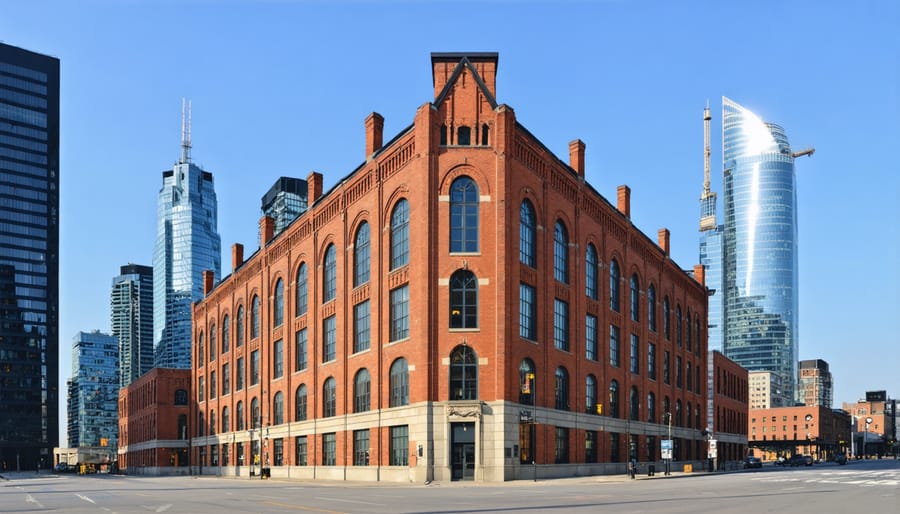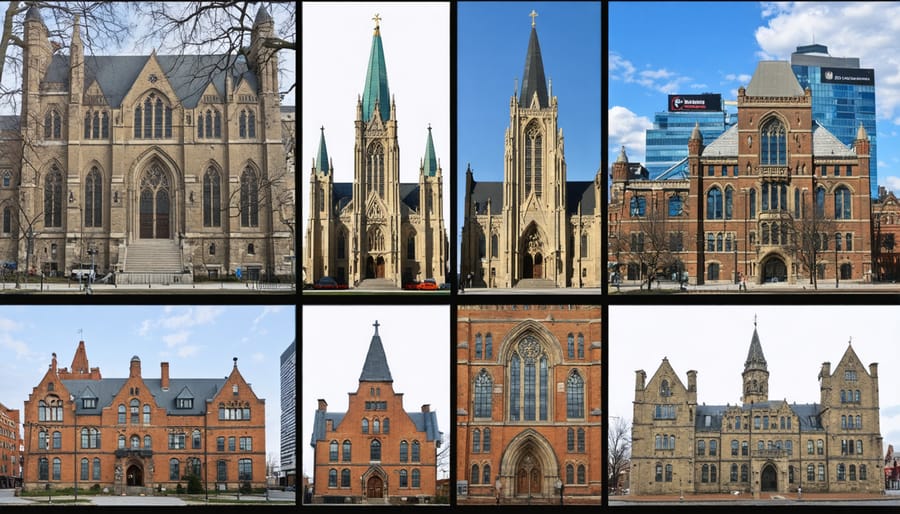Architectural landmarks stand as silent storytellers, weaving tales of human ingenuity, cultural heritage, and societal evolution through their towering spires, weathered stones, and innovative designs. From the awe-inspiring Gothic cathedrals of medieval Europe to the sleek, sustainable skyscrapers reshaping modern cityscapes, these magnificent structures serve as both functional spaces and powerful symbols of their time.
Ontario’s rich architectural heritage particularly shines through its diverse collection of landmarks, each reflecting distinct periods of the province’s development. From the stalwart military fortifications that once guarded our shores to the elegant Victorian-era civic buildings that grace our town squares, these structures offer fascinating glimpses into our past while continuing to shape our present-day communities.
As we explore these architectural treasures, we discover more than just beautiful buildings – we uncover the stories of the visionaries, craftsmen, and communities that brought them to life. Whether you’re a history enthusiast, photography lover, or curious traveler, Ontario’s architectural landmarks invite you to step back in time while appreciating the enduring beauty and innovation that make them relevant even today.
Remember to check visiting hours and photography policies before exploring these magnificent structures, as many still serve as active community spaces or protected heritage sites.

Fort Henry: Kingston’s Military Marvel
The Fort’s Strategic Design
The fort’s architecture masterfully combines defensive practicality with strategic ingenuity, making it one of Ontario’s most dramatic colonial forts. Its star-shaped design wasn’t just for show – the pointed bastions eliminated blind spots and allowed defenders to maintain clear sight lines in all directions. These clever architectural features meant that a relatively small garrison could effectively protect a large area.
The thick limestone walls, locally quarried and carefully fitted, still stand as a testament to the builders’ skill. Rising 30 feet high in some sections, these walls were specifically engineered to withstand cannon fire while providing a stable platform for the fort’s own artillery. The elevated gun platforms, strategically positioned around the perimeter, offered commanding views of both water and land approaches.
Inside, you’ll find an impressive network of storage rooms and powder magazines, built with vaulted ceilings to protect vital supplies. The soldiers’ barracks were thoughtfully designed with large windows for ventilation during hot summers, while the officers’ quarters featured separate dining areas and private chambers – a nod to the strict military hierarchy of the time.
Visitor Experience Today
Today, these architectural treasures serve as vibrant cultural hubs, drawing visitors from around the globe. Many landmarks host seasonal events that bring history to life, from Victorian Christmas celebrations to summer garden parties that transport guests back in time. Interactive guided tours are available at most sites, offering fascinating insights into early Ontario life and architectural innovations.
During peak season (May to October), visitors can enjoy special exhibits, historical reenactments, and hands-on workshops that demonstrate traditional building techniques. Photography enthusiasts will find plenty of inspiration, especially during golden hour when the historic stonework takes on a warm, ethereal glow. For the best experience, visit during weekday mornings when crowds are thinner.
Many landmarks have adapted to modern needs while preserving their historical integrity. You’ll find accessible pathways, interpretive centers, and digital exhibitions that complement the original architecture. Some sites offer evening tours by lantern light, providing a uniquely atmospheric experience of these historic spaces.
Pro tip: Consider purchasing a heritage passport, which offers discounted access to multiple landmarks and includes special perks like priority entry during peak times and exclusive member events.
Gooderham Building: Toronto’s Flatiron Beauty
Victorian Architecture Meets Modern City
In the heart of Ontario’s bustling cities, Victorian-era architecture stands as a testament to our rich architectural heritage, creating a stunning contrast with modern glass-and-steel structures. These magnificent buildings, many of which are now designated as industrial heritage landmarks, showcase the intricate craftsmanship of 19th-century builders.
Walking through downtown areas, you’ll spot distinctive features like decorative brick patterns, elaborate cornices, and ornate window frames that characterize the Victorian style. Local architects of the time favored steep-pitched roofs, asymmetrical facades, and wrap-around porches, creating buildings that exude both grandeur and charm.
What makes these structures truly special is how they’ve adapted to modern use while preserving their historical integrity. Many now house trendy restaurants, boutique hotels, or innovative tech startups, proving that good design transcends time. Look out for the iconic red and yellow brick combinations, gothic-inspired windows, and detailed woodwork – these elements tell stories of Ontario’s architectural evolution from a colonial outpost to a contemporary urban center.

Photography Tips and Best Viewing Spots
For the best photographs, visit during the “golden hours” – early morning or late afternoon – when the sunlight casts warm, dramatic shadows across the architectural details. The north side of the building offers excellent lighting conditions throughout the day, while the south facade is best captured in the early morning to avoid harsh shadows.
Bring a wide-angle lens to capture the full grandeur of the structure, and don’t forget to pack a zoom lens for those intricate architectural details in the upper portions. Pro tip: photographing during overcast days can actually help reduce contrast and reveal more architectural details in your shots.
Popular viewing spots include the east garden, which provides an unobstructed view of the main entrance, and the northwest corner, offering a perfect angle for capturing the building’s most distinctive features. For interior shots, tripods are allowed but remember to check with staff about flash photography restrictions.
Visit during off-peak hours (typically before 10 AM or after 3 PM) to avoid crowds in your shots. Winter months often provide unique photo opportunities with frost-covered details and dramatic sky backgrounds. Don’t miss the chance to capture reflections in the nearby pond during calm mornings.
Sharon Temple: A Unique Architectural Wonder
Symbolic Architecture
The temple’s design seamlessly blends traditional European architectural elements with subtle nods to indigenous heritage sites, creating a unique architectural signature that’s distinctly Ontario. The most striking feature is its soaring bell tower, which reaches 120 feet into the sky and serves as a beacon visible from miles around. Local limestone, quarried just fifteen minutes from the site, gives the building its characteristic warm, honey-colored glow at sunset.
Look closely at the intricate carvings around the main entrance – they tell stories of the region’s early settlers through a series of beautifully preserved motifs. The building’s east-facing windows were specifically designed to catch the morning light, creating a magical display of colors through the stained glass that locals affectionately call the “sunrise symphony.”
What makes this landmark truly special is how it incorporates natural elements into its design. The roof’s gentle slopes mirror the surrounding hills, while the courtyard’s layout follows the natural contours of the land, making it feel like the building simply grew from the earth itself.
Visiting the Temple
Today, this architectural marvel welcomes visitors year-round, with preservation efforts carefully balancing public access and historical conservation. The site is open daily from 9 AM to 5 PM, with extended summer hours until 7 PM. Admission is $12 for adults, $8 for seniors and students, while children under 12 enter free.
To make the most of your visit, join one of the guided tours offered every two hours. These engaging walks reveal fascinating architectural details and stories you might otherwise miss. For the best experience, visit during weekday mornings when crowds are thinner, and the light is perfect for photography.
Conservation work is ongoing, with recent efforts focusing on stabilizing the foundation and restoring original stonework. Visitors can watch craftspeople at work during restoration seasons, typically spring and fall. The gift shop supports these preservation initiatives, with proceeds funding vital maintenance.
Pro tip: Download the site’s free audio guide app before your visit – it offers rich historical context and helps you explore at your own pace. Remember to wear comfortable shoes, as the historic flooring can be uneven in places.

Parliament Buildings: Gothic Revival Grandeur
Architectural Heritage
The Gothic Revival style that swept through Ontario in the mid-19th century left an indelible mark on our architectural landscape. This dramatic architectural movement reflected Victorian ideals and a romantic fascination with medieval design, resulting in buildings that still capture our imagination today.
Walking through Ontario’s historic districts, you’ll notice the telltale signs of Gothic Revival: pointed arches, steep gabled roofs, and intricate decorative elements known as finials. These features weren’t just for show – they represented a cultural shift towards more ornate, spiritually-inspired architecture that broke away from the simpler Georgian styles of earlier decades.
Local architects adapted Gothic Revival to suit Ontario’s unique needs and materials. While European Gothic buildings were typically crafted from stone, many Ontario examples cleverly used local brick and wood, creating a distinctly Canadian interpretation of the style.
What makes these buildings especially remarkable is how they’ve weathered time and changing tastes. Many continue to serve their original purposes, while others have been thoughtfully repurposed for modern use – a testament to both their sturdy construction and timeless appeal. Keep an eye out for the distinctive Gothic Revival features on your next walk through any of Ontario’s historic neighborhoods!
Tourist Access and Tours
Many of Ontario’s architectural landmarks welcome visitors year-round, offering guided tours that bring their rich histories to life. Most buildings are accessible during regular business hours, with extended summer hours from May to September. We recommend booking guided tours in advance, especially during peak tourist season.
For the best experience, join a knowledgeable local guide who can share fascinating stories about the buildings’ construction, historical significance, and architectural features. Many sites offer both group and private tours, with options ranging from 30-minute overviews to in-depth 2-hour explorations.
Photography is generally permitted in public areas, though some interior spaces may have restrictions. Be sure to check specific guidelines before your visit. Many locations offer free admission to their grounds, while interior tours typically range from $10-25 per person, with discounts available for seniors, students, and children.
Pro tip: Consider visiting during Doors Open Ontario events, when many historical buildings offer free access and special behind-the-scenes tours. These annual events usually occur on weekends throughout spring and summer, providing unique opportunities to explore areas normally closed to the public.
Remember to wear comfortable walking shoes and bring a camera – you’ll want to capture the stunning architectural details!
Planning Your Architectural Heritage Tour
Planning a successful architectural heritage tour requires careful timing and preparation to make the most of your experience. The best seasons to explore Ontario’s architectural landmarks are spring and fall when the weather is mild and the crowds are manageable. Summer offers extended daylight hours but can be busy, while winter provides unique photo opportunities with snow-covered structures, particularly when visiting historic military structures.
For photography enthusiasts, early morning and late afternoon provide the best lighting conditions, creating dramatic shadows and warm hues that highlight architectural details. Pack a wide-angle lens for capturing entire buildings and a zoom lens for detailed architectural elements. Consider bringing a tripod for low-light situations, especially when photographing interiors.
Many landmarks offer guided tours, which we recommend booking in advance, particularly during peak season. These tours often provide access to areas not open to the general public and share fascinating stories about the buildings’ history. Download relevant mobile apps or grab physical maps from visitor centers to create an efficient route between sites.
Pro tip: Consider purchasing a heritage passport or membership that offers access to multiple sites – it’s often more economical than individual entrance fees. Pack comfortable walking shoes, as many architectural tours involve considerable walking on various surfaces.
Remember to be respectful of active religious sites and government buildings, checking their visiting hours and photography policies beforehand. Many locations offer specialized photography permits for serious enthusiasts. During summer months, carry water and sun protection, as many historic sites have limited shade.
For the eco-conscious traveler, consider using public transportation or joining organized walking tours to reduce your carbon footprint. Many cities offer heritage-specific bus routes or walking trails connecting multiple landmarks, making it easier to explore sustainably while maximizing your time.
Ontario’s architectural landmarks stand as living testaments to our rich cultural heritage, telling stories of pioneering spirit, architectural innovation, and community development. These precious structures deserve our attention and protection, not just as tourist attractions, but as valuable connections to our past that continue to shape our present.
By visiting and supporting these landmarks, we contribute to their preservation for future generations. Many of these buildings still serve their original purposes while others have been thoughtfully repurposed, demonstrating how historical preservation and modern functionality can work hand in hand. Remember to check ahead for guided tours, which often provide fascinating insights and access to areas normally closed to the public.
When exploring Ontario’s architectural gems, consider using public transportation or joining organized walking tours to reduce your environmental impact. Many sites now offer virtual tours and educational programs, making our architectural heritage accessible to everyone, regardless of location or mobility.
As stewards of these remarkable buildings, we all play a role in their conservation. Support local heritage organizations, participate in preservation initiatives, and share these architectural treasures with friends and family. Every visit helps ensure these landmarks remain vibrant parts of Ontario’s landscape for centuries to come.
Our architectural landmarks aren’t just buildings – they’re bridges between past and present, reminding us of where we’ve come from and inspiring where we’re going. Let’s cherish and protect these irreplaceable pieces of our heritage.














+ There are no comments
Add yours